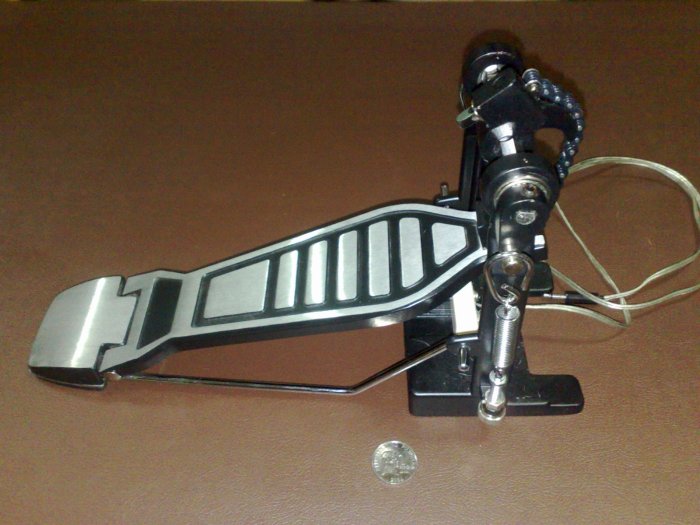Embark on a rhythmic odyssey with the rock band drum pedal, an essential tool that transforms the art of drumming into a captivating symphony. Dive into the intricacies of this dynamic component, unraveling its secrets to unleash the full potential of your percussive prowess.
From deciphering the mechanics to mastering advanced techniques, this comprehensive guide empowers you to elevate your drumming to new heights, leaving an unforgettable mark on every beat you strike.
Drum Pedal Basics

A drum pedal is a crucial component of a rock band drummer’s setup. It allows the drummer to control the bass drum with their foot, enabling them to create rhythms and grooves. Drum pedals come in various types, each with its unique feel and functionality.
Some common types of drum pedals include:
- Single pedals: These pedals have one beater and are used for basic drumming patterns.
- Double pedals: These pedals have two beaters, allowing drummers to play more complex rhythms.
- Chain-driven pedals: These pedals use a chain to connect the beater to the footboard, providing a smooth and responsive feel.
- Direct-drive pedals: These pedals have a direct connection between the beater and the footboard, offering a more powerful and precise feel.
Popular drum pedal brands and models include:
- Tama Iron Cobra
- DW 9000
- Pearl Demon Drive
- Yamaha FP9
- Sonor Perfect Balance
Drum Pedal Components
The key components of a drum pedal include:
- Beater: The beater strikes the bass drum head, producing the sound.
- Footboard: The footboard is where the drummer’s foot rests, allowing them to control the beater.
- Spring: The spring provides tension, which helps the beater return to its starting position after striking the drum head.
Different components affect the feel and performance of the pedal. For example, a heavier beater will produce a louder sound, while a stiffer spring will provide more resistance and require more force to play.
Drum Pedal Adjustment

Adjusting a drum pedal for optimal performance is essential. Here are some key adjustments:
- Beater angle: The beater angle affects the sound and feel of the pedal. A steeper angle will produce a brighter sound, while a flatter angle will produce a warmer sound.
- Footboard height: The footboard height affects the drummer’s comfort and playing position. A higher footboard will require the drummer to lift their foot higher, while a lower footboard will allow them to play with less effort.
- Spring tension: The spring tension affects the feel and responsiveness of the pedal. A tighter spring will provide more resistance, while a looser spring will allow the beater to rebound more quickly.
Experimenting with different adjustments will help drummers find the optimal setup for their playing style and preferences.
Drum Pedal Techniques

Rock band drummers use various techniques to achieve specific sounds and rhythms.
- Heel-toe technique: This technique involves using both the heel and toe to play the pedal, allowing for fast and intricate patterns.
- Double bass technique: This technique involves using both feet to play the pedal, enabling drummers to create powerful and driving rhythms.
- Shuffle technique: This technique involves playing a series of quick, even strokes, creating a rolling sound.
These techniques are often used in popular rock songs, such as “Kashmir” by Led Zeppelin and “Enter Sandman” by Metallica.
Drum Pedal Maintenance
Regular maintenance is crucial to ensure the longevity and optimal performance of a drum pedal.
- Cleaning: Use a damp cloth to clean the pedal regularly, removing any dirt or debris.
- Lubrication: Lubricate the pedal’s moving parts, such as the bearings and springs, to reduce friction and wear.
- Troubleshooting: If the pedal is not functioning properly, check for loose screws, worn parts, or other issues that may require repair or replacement.
Proper maintenance will help keep the pedal in good condition and extend its lifespan.
Drum Pedal Accessories
Various accessories are available to enhance the performance or customization of a drum pedal.
- Beater weights: These weights can be added to the beater to increase its mass, resulting in a louder and more powerful sound.
- Toe stops: These stops can be attached to the footboard to prevent the foot from slipping off.
- Pedalboards: These boards provide a stable and secure platform for mounting multiple pedals, allowing drummers to create complex setups.
Professional drummers often use these accessories to improve their playing experience and create unique sounds.
Essential FAQs: Rock Band Drum Pedal
What is the purpose of a drum pedal?
A drum pedal is a mechanical device that allows a drummer to strike a drum’s beater using their foot, enabling precise and rapid playing.
How do I adjust my drum pedal for optimal performance?
Adjusting the beater angle, footboard height, and spring tension can optimize your pedal’s feel and responsiveness. Experiment with different settings to find what works best for your playing style.
What are some common drum pedal techniques?
Heel-toe technique, double bass drumming, and ghost notes are popular techniques that enhance rhythmic complexity and versatility.
